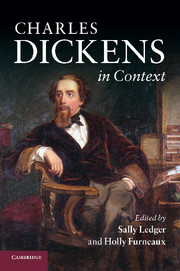Book contents
- Frontmatter
- Contents
- List of illustrations
- Notes on contributors
- Preface
- Notes on references
- PART I LIFE AND AFTERLIFE
- PART II SOCIAL AND CULTURAL CONTEXTS
- 12 Popular culture
- 13 The rise of celebrity culture
- 14 The newspaper and periodical market
- 15 Authorship and the professional writer
- 16 The theatre
- 17 Melodrama
- 18 The Bildungsroman
- 19 Visual culture
- 20 The historical novel
- 21 The illustrated novel
- 22 Christmas
- 23 Childhood
- 24 Work
- 25 Europe
- 26 The Victorians and America
- 27 Educating the Victorians
- 28 London
- 29 Politics
- 30 Political economy
- 31 The aristocracy
- 32 The middle classes
- 33 Urban migration and mobility
- 34 Financial markets and the banking system
- 35 Empires and colonies
- 36 Race
- 37 Crime
- 38 The law
- 39 Religion
- 40 Science
- 41 Transport
- 42 Illness, disease and social hygiene
- 43 Domesticity
- 44 Sexuality
- 45 Gender identities
- Further reading
- Index
42 - Illness, disease and social hygiene
Published online by Cambridge University Press: 05 August 2012
- Frontmatter
- Contents
- List of illustrations
- Notes on contributors
- Preface
- Notes on references
- PART I LIFE AND AFTERLIFE
- PART II SOCIAL AND CULTURAL CONTEXTS
- 12 Popular culture
- 13 The rise of celebrity culture
- 14 The newspaper and periodical market
- 15 Authorship and the professional writer
- 16 The theatre
- 17 Melodrama
- 18 The Bildungsroman
- 19 Visual culture
- 20 The historical novel
- 21 The illustrated novel
- 22 Christmas
- 23 Childhood
- 24 Work
- 25 Europe
- 26 The Victorians and America
- 27 Educating the Victorians
- 28 London
- 29 Politics
- 30 Political economy
- 31 The aristocracy
- 32 The middle classes
- 33 Urban migration and mobility
- 34 Financial markets and the banking system
- 35 Empires and colonies
- 36 Race
- 37 Crime
- 38 The law
- 39 Religion
- 40 Science
- 41 Transport
- 42 Illness, disease and social hygiene
- 43 Domesticity
- 44 Sexuality
- 45 Gender identities
- Further reading
- Index
Summary
Like so many of his time, Charles Dickens was intimately acquainted with the effects of illness and disease. Small for his age and afflicted with spasms of renal colic, young Charles was no stranger to physical pain. By the time he was 12, he had witnessed the close association of disease and poverty. The squalor of the Marshalsea prison, in which his father was detained for debt, and the illnesses of its inmates, impressed him with a lasting horror. As an adult, Dickens was shocked by the mysterious sudden sickness and death of his 17-year-old sister-in-law Mary Hogarth, who died in his arms. He nursed several of his ten children through febrile illnesses, probably both typhus and cholera, and lost one infant daughter. His favourite sister, Fanny, died an agonised death of consumption, or what we now call pulmonary tuberculosis. Later in life Dickens suffered from high blood pressure and cerebral vascular disease. He died at the age of 58 of a cerebral haemorrhage.
This long list of illnesses was not untypical for a Victorian family. Members of all socio-economic classes were well acquainted with consumption, which was endemic throughout Britain, causing a chronic, often bloody cough, intermittent fever, a long wasting illness and early death. Cholera epidemics swept the country in 1831/2, 1848/9 and again in 1853/4. A particularly terrifying illness, cholera provoked violent diarrhoea, rapid dehydration and circulatory collapse, killing about half of its victims – often within days.
- Type
- Chapter
- Information
- Charles Dickens in Context , pp. 343 - 349Publisher: Cambridge University PressPrint publication year: 2011



